ooo~Shiney!
Brilliant_Rock
- Joined
- Jun 6, 2010
- Messages
- 1,501
colorluvr|1297493348|2849843 said:jstarfireb|1297492590|2849838 said:If deMANtoids have sperm, are there dewomantoids to mate with?
Absolutely, I'm sure of it (of course, I have no proof)But I'd love to own one of their offspring!
The debabytoids would be more or less saturated?
If they are quite saturated, then wouldn't they stand to be confused with the ubiquitous Urinite?





300x240.png)